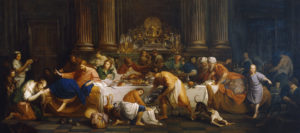Object of the Month: April 2015
Christ in the House of the Pharisee
Oil on canvas
Pierre Hubert Subleyras
French, active in Italy, 1699–1749
Click on the links throughout the article to view additional artists’ works and reference material.
As one of the eighteenth-century’s foremost French painters of portraits and religious works, Pierre Hubert Subleyras is considered a remarkable artist and rarely seen in American collections.
Pierre was introduced to the craft from his artist father, Matthieu Subleyras, and by age seventeen was signing his own works. In 1717, he joined the workshop of Antoine Rivalz, a history painter in Toulouse a few days journey west of his hometown, Saint-Gilles-du-Gard. Subleyras excelled under Rivalz’s training even earning the responsibility of executing his teacher’s designs and achieving an independent commission to decorate the ceiling of the chapel of the Pénitents Blancs in Toulouse, France.
At age 27, Subleyras moved to Paris, where he was awarded the Prix de Rome for his Moses and the Brazen Serpent (Musée des Beaux Arts, Nimes). This scholarship program initiated by King Louis XIV was given to the most promising French artists (painters, sculptors and architects) to study in Rome for a three to five year period.
Pierre left for Rome in 1728 to begin studies in the fall at the Académie de France, a branch of the Paris Royal Academy of Painting and Sculpture where “pensioners” or students studied anatomy, life drawing, and classical antiquity as well as absorbed and participated in Rome’s thriving contemporary art scene. Subleyras stayed seven years—somewhat longer than the more standard 4-year term.
At the end of his Académie training in 1735 at age 36, he became engaged to the miniaturist and respected artist in her own right, Maria Felice Tibaldi; the two artists married four years later, which helped to anchor the Frenchman in Rome’s society, where he couldn’t be lured away from the city even by a deathbed request from his former teacher Rivalz or appealing mediations with the Saxon Court in Dresden nor the Spanish Court in Madrid.
Subleyras’ artistic reputation was earned primarily through religious commissions beginning with Roman churches and moving to religious orders, but he was also highly regarded and widely recognized for his portraits. Through his intellect and skilled work he became a central figure in the artistic and intellectual circles of Rome as evidenced by his varied commissions, election in 1743 to membership of the Accademia di San Luca, and acceptance into the Accademia dell’ Arcadia, an eighteenth-century Italian literary society.
His best known works include a formal portrait of Prince Frederick Christian of Saxony, portraits of Pope Benedict XIV (which were repeatedly reproduced), the Mass of St. Basil, and the monumental Supper in the House of Simon (nearly 7’x23’) commissioned by the Canons Regular of the Lateran for the refectory of their monastery of Santa Maria Nuova at Asti, Piedmont (and currently resides in the Louvre).
Since Subleyras’ workshop practice is yet uncertain, with questions about his making multiple, smaller copies of his large-scale masterpieces, it’s difficult to ascertain his reasons for repeating these works as well as if he or someone else, like his wife, participated in creating the variations. The Louvre painting is one of a number of his own works that he made his own prints and an engraving; like this present painting at M&G, variations also exist in the Pinacoteca Capitolina Museum in Rome, Boston College Museum, and the Museum of Fine Arts, Boston.
Periodically, Christ in the House of the Pharisee is featured in the annual Living Gallery, an Upstate Easter program. The original painting in M&G’s Collection, is relatively small—about 2½’x4’. However, the life-size Living Gallery reproduction, scaled for live models, is approximately 12’ high by 25’ wide—closer to the dimensions of the Louvre’s version. The life-size stage tableau was created by local artist, Kevin Isgett, who relates his experience with Subleyras’ work:
“There is a baroque sense of overabundance—a sense of frenetic activity, servants running to and fro, guests interacting, and (almost lost in the chaos) the key part of the narrative: the woman anointing Christ’s feet. In analyzing the work, however, I wonder if that is not part of what Subleyras is trying to communicate. Unlike the disciples at the Last Supper who knew and loved Christ as the Messiah, the Pharisees viewed Him as a mere dinner guest. Thus, losing sight of Him amidst elegantly dressed characters and lavish gold and silver plates may be the most accurate interpretation of the scene.”
Subleyras died at a young 50 years, supposedly from overwork. Well-loved and well-known during his lifetime, he spent his entire career in Rome. He is not as familiar as his French contemporaries, but is still highly regarded today for his painterly style and refined, artistic sensibility.
Erin R. Jones, Executive Director
Published in 2015
